What’s Your Diagnosis? A Case Study
When a 35-year-old woman presented for her first ultrasound at 30 weeks’ gestation, the images revealed a very rare condition. Can you identify it?
Presented here is a case report involving a 30-week pregnancy for which the mother underwent routine ultrasonography.
History and Examination
A 35-year-old woman presented for a routine ultrasonographic examination at 30 weeks' gestation. Prior to this pregnancy, her menstrual cycles were normal. She had no history of any major illness before the ultrasound screening.
Family history: This patient, the mother, was 1 of 5 children. This was her first pregnancy.
Present pregnancy: The patient had been amenorrheic for 30 weeks, which almost corresponded to the gestational age of the fetus on ultrasound scan. She had no history of antepartum hemorrhage or discharge during this pregnancy and reported feeling normal fetal movement.
Clinical examination: The patient’s blood pressure was normal at 122/84 mm Hg, as were her other vital signs. There were no abnormal findings on chest examination. The abdominal examination revealed a fundal height that almost corresponded to the gestational age of 30 weeks.
Imaging studies: This patient underwent routine transabdominal ultrasonography to exclude any congenital abnormalities. This was her first ultrasound scan. The images from this examination follow.
Image 1. This B-mode ultrasound scan shows an axial section of the fetal chest.
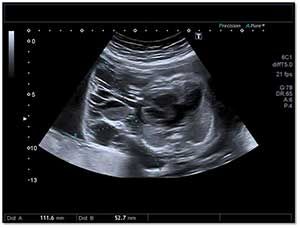
Image 2. Another axial section of the fetal chest is shown in this B-mode ultrasound scan.
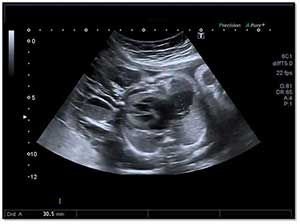
(Images in this case study are courtesy of Durr-e-Sabih, MD, FRCP.)
Based on these images of the fetal chest, what's your diagnosis?
Ultrasonographic Findings
The most obvious finding in Images 1 and 2 appears to be some mass lesions along the left chest wall in the fetus. In addition, there appears to be a cystic lesion to the right of the fetal heart. What do these findings imply?
A diagnosis of congenital diaphragmatic hernia might explain the cystic lesion in the thorax to the right of the fetal heart. However, there also is a large mass that is complex in nature along the left chest wall with possible extension into the thoracic cavity. Does a congenital diaphragmatic hernia still make sense as a differential diagnosis, or does another disease or anomaly better explain both an intrathoracic cystic mass and an extrathoracic cystic mass? Shall we see more images?
Image 3.This 3-D ultrasound scan shows the fetal chest and neck.
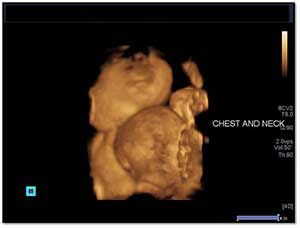
Image 4. This B-mode ultrasound scan shows the fetal neck.
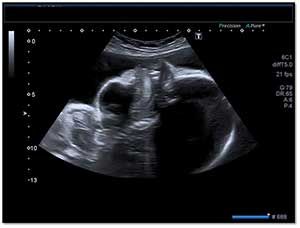
Image 5. This 3-D ultrasound scan shows the fetal neck and face.
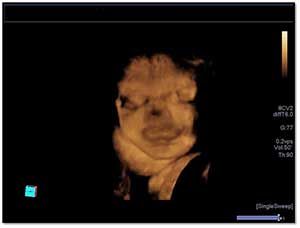
After reviewing Images 3, 4, and 5, the most obvious finding is a cystic lesion in the neck. But notice the fetal tongue? It appears large and seems to protrude through the fetal mouth. What are we dealing with? Are these random, unrelated congenital anomalies? Could it be a syndrome? If so, what syndrome can possibly explain and connect these findings?
The mass in the fetal neck is primarily cystic. So we have a cystic lesion in the thoracic cavity, another along the chest wall, and now a cystic lesion in the fetal neck. And this lesion in the fetal neck-what does it do? It appears to push the fetal tongue and may have caused macroglossia. Can we explain these findings? Is it a case of ectopia cordis? But look again; the fetal heart appears to be well within the confines of the thoracic cage. Therefore, ectopia cordis can be excluded.
Is this a case of omphalocele or gastroschisis? After review of these images, do the masses reveal a breach in the abdominal wall? There is no obvious bowel content or liver within any of these thoracic masses. Can we explain the chest lesion as a case of congenital diaphragmatic hernia? Look again. There appears to be no disruption of the diaphragm in any of these images. The cystic lesion to the right of the fetal heart can, thus, not be the fetal stomach.
To review, the findings of significance are multiple, primarily cystic, lesions along the chest wall, within the right hemithorax, and a large lesion within the fetal neck that has displaced the tongue. What fetal syndrome can explain these multiple cystic lesions? What is the most common cause of cystic lesions in the fetal neck? What about cystic hygroma? A cystic hygroma can explain the fetal neck lesion, but does cystic hygroma extend deep into the fetal neck and chest?
Final Diagnosis
Multiple cervicomediastinal cystic hygroma (or multiple cystic hygromas of fetal neck and chest)
Discussion
Cystic hygroma is a type of lymphatic malformation. Lymphatic fluid collects within the cysts or lymphatic channels, usually in the soft tissue, though it can extend into the muscle and even the thorax. Cystic hygromas contain lymph, the fluid that normally circulates throughout the lymphatic system. When the flow of lymph is obstructed, it results in a cystic dilation of the lymphatic ducts, resulting in cystic hygroma. “Lymphatic malformation” is increasingly replacing “cystic hygroma” as the favored term. Cystic hygroma literally means water tumor, making it a misnomer for the condition it represents.
Types: Medical literature describes several types of cystic hygroma based on the location in the fetus. These include the following:
- Cervical (75% of cases).
- Axillary (20% of cases).
- Retroperitoneal/abdominal (2% of cases).
- Limbs, bones, or scrotum (2% of cases).
- Cervicomediastinal (1% of cases).
Differential diagnoses: The differential diagnoses for cystic hygroma include cervical teratoma, omphalocele, limb body wall complex, gastroschisis, and ectopia cordis. As previously described, careful study of the lesions will help differentiate each of these conditions from cystic hygroma.
References:
Reference
Suma V, Marini A, Gamba P, Luzzato C. Cystic hygroma, axillary, cervico-mediastinal. Available
here
. Accessed September 23, 2013.
S1E4: Dr. Kristina Adams-Waldorf: Pandemics, pathogens and perseverance
July 16th 2020This episode of Pap Talk by Contemporary OB/GYN features an interview with Dr. Kristina Adams-Waldorf, Professor in the Department of Obstetrics and Gynecology and Adjunct Professor in Global Health at the University of Washington (UW) School of Medicine in Seattle.
Listen
Study shows a healthy prenatal diet could be upstream obesity prevention strategy
December 26th 2024"Our findings support the recommendation of a healthy diet based on the current guidelines (as measured by the HEI) during pregnancy, since it may reduce patterns of infant growth outside reference ranges."
Read More
Early pregnancy cannabis use high in states with recreational legalization
November 11th 2024A population-based time-series analysis California before, during and after legalization show a rising trend in women using cannabis while pregnancy especially when the state has legalized the drug.
Read More
